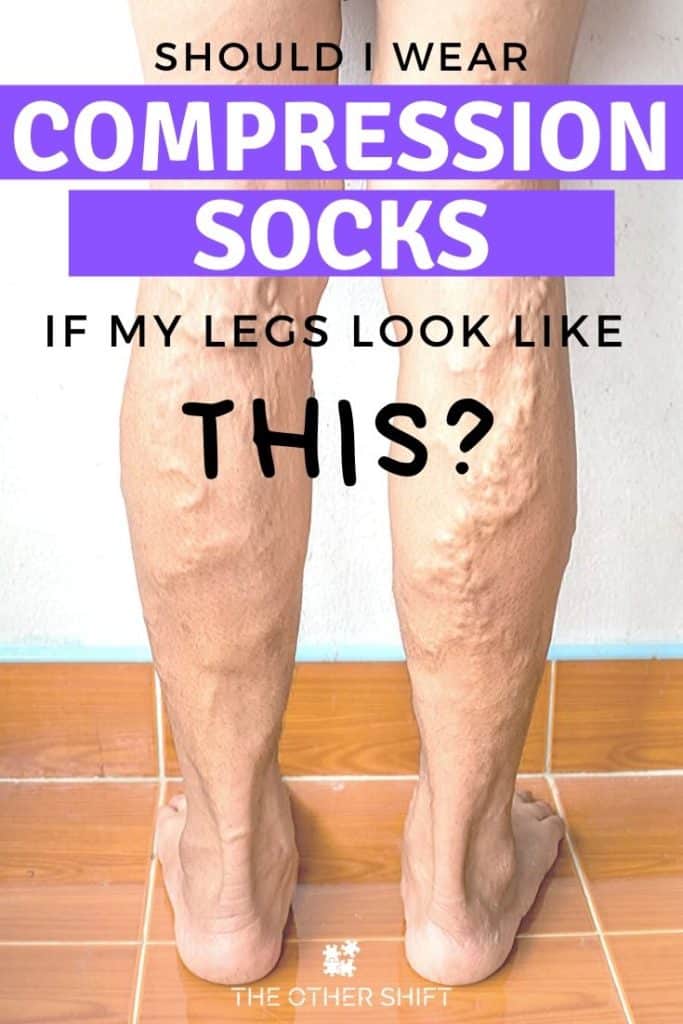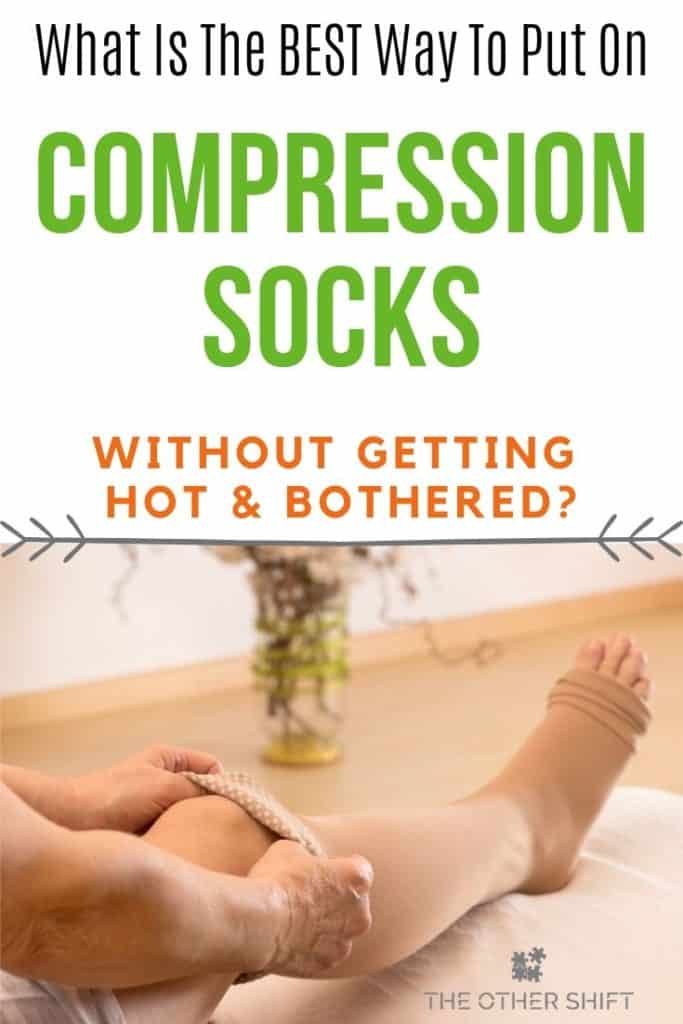Disclosure: This page may contain affiliate links, meaning we receive a commission if you decide to make a purchase through our links, but this is at no additional cost to you. Please read our disclosure and privacy statement for more info.
Are your feet becoming unrecognizable during or after a days work? Do they painfully ache and throb distracting you from your job? Wearing compression socks could be a simple solution to your woes, but it’s important you look at a few things, like your own medical history before adding these seemingly innocent socks to your morning routine.
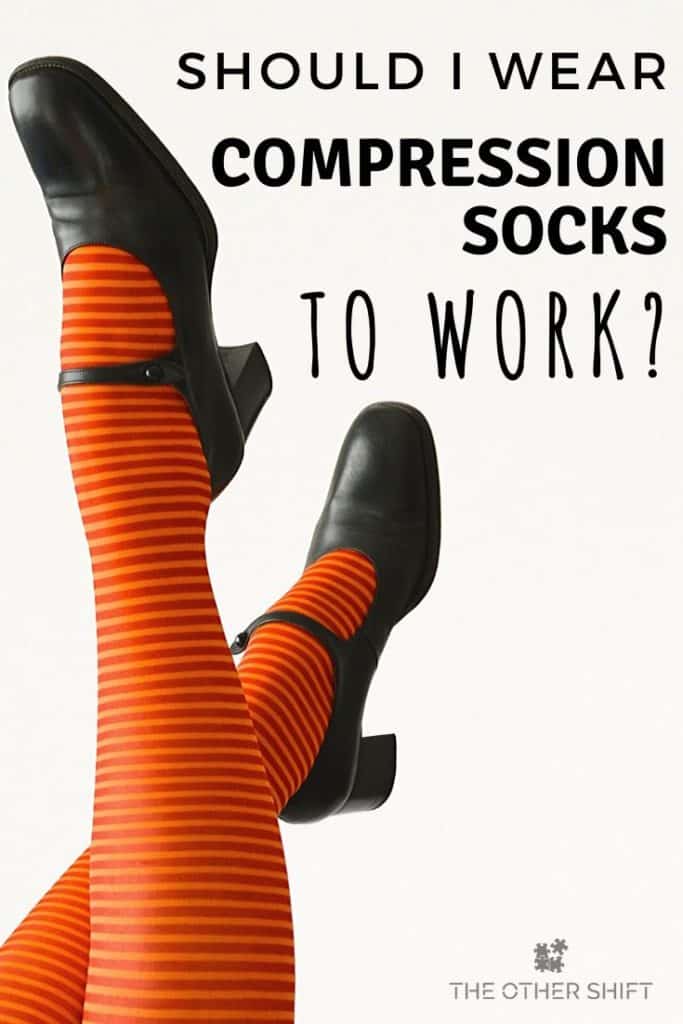
In most cases, wearing compression socks to work will be beneficial in promoting blood flow back to the heart and preventing clots from forming. However, there are some cases, such as with peripheral vascular disease, where compression socks are not appropriate.
While most people know that compression socks are recommended to be worn by pregnant women, on long haul flights, after recent surgery, during forced bed rest from your doctor, if you have varicose veins or when treating leg ulcers…what about during work?
This post explores this simple question while also giving you tips on what you should look for prior to running to the supermarket or browsing through Amazon for your next pair of socks.
Should I Wear Compression Socks at Work?
In most cases, there is absolutely a benefit to wearing compression socks at work.
They will not only help reduce the throbbing and aching in your legs but they should also reduce the swelling you’ve probably noticed around your ankles after a long day. “Kankles” is the technical word my nursing mates call them…
But there a few exceptions where wearing compression socks should be avoided such as:
- If you have nerve damage in your legs or another condition that affects skin sensation
- Peripheral Arterial Disease (PVD) where you cannot feel, or have very little feeling in your toes and feet
- A history of peripheral arterial bypass grafting. Sounds intense, but you’ll know if you’ve had it
- You have a skin infection on your feet or legs like dermatitis, with oozing or fragile skin
- Abnormal leg swelling you don’t know the cause of
- Pulmonary edema from congestive heart failure. In English, this means shortness of breath caused by fluid on the lungs often due to a poorly pumping heart
You might be asking why are these health conditions above a problem in wearing compression socks?
Well, something like peripheral arterial bypass grafting, for example, is where there is a blockage in one of the arterials in the legs or “peripheries” so the doctor has to use an artery from somewhere else to “bypass” the blockage.
This, as you can imagine, is very specific and detailed work, either resulting in better blood flow to the area after the new graft or not. You don’t want to be messing around with this skilful work by putting extra pressure on the new artery with compression socks.
A lot of the other issues I mentioned on the list are all about blood flow and making sure the damaged area is receiving enough “oxygen-rich” blood to either heal something or keep something alive.
Because in the end, the point of compression socks is to provide consistent pressure along the leg and keep the blood moving. This pressure encourages blood to flow from your ankles, through the veins and eventually to your heart.
“They may even stop you from feeling light-headed or dizzy when you stand up”.
Web MD
Confused about your own medical past history? See your doctor. We actually recommend before you start wearing compression socks to see your doctor and get advice on the different levels in socks and if they are appropriate at all – but more on that later.
If you do get the go-ahead from your doctor during this appointment, make sure they measure you properly so you know what you’re looking for when either in-store or buying online.
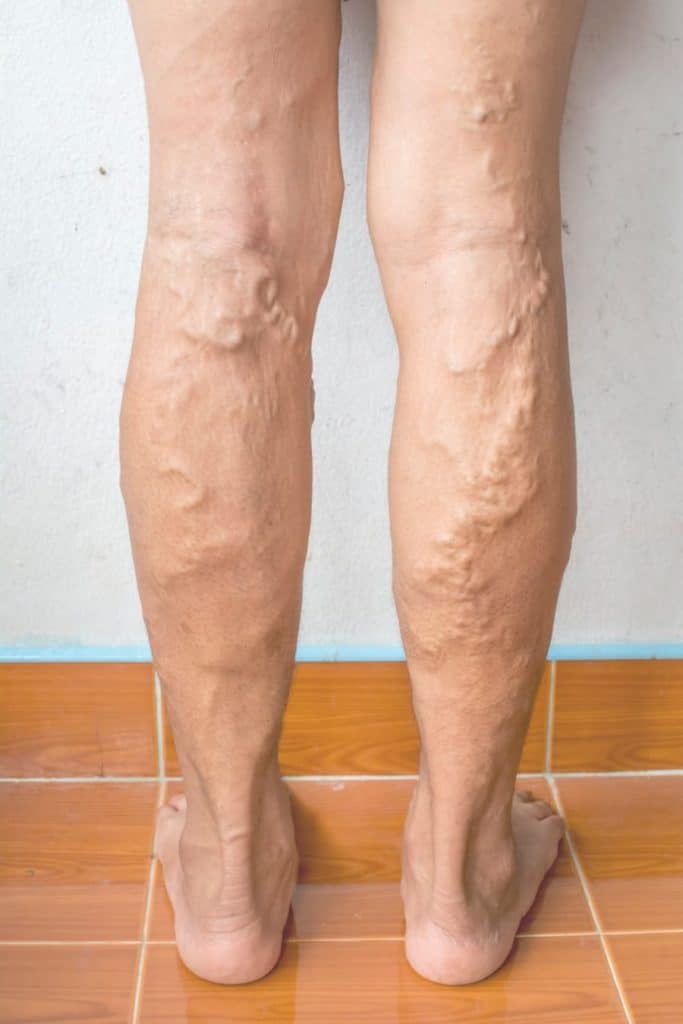
Some compression socks such as those perscribed for varicose veins can be claimed on insurance – so don’t forget to ask your doctor!
What Are Good vs Bad Compression Socks to Wear to Work?
It seems like every sock company in the universe is now creating compression socks too!
But how in the world are you supposed to choose the right ones specific for you when you don’t know a thing about them?
Well, let me help. Here is my “very technical” ranking scale.
| Good | Bad |
| They decrease pain and swelling during and after a shift | You still have swollen, achy legs after work |
| They stay up for your entire shift | They constantly fall down |
| They don’t cause you to itch your leg constantly | Too tight causing sores behind your knees |
| They are breathable | You still get clots |
| Are not so thick you can’t get on your regular work shoes | They annoy you causing you to feel hot and bothered |
| Aesthetically pleasing (if you care about this) | The “grade” or pressure is not appropriate for treating your specific needs. |
| Not necessarily the most expensive | Digging in around your toes causing inflammation, reddness and sores. |
In my naive experience as a brand new nurse a decade ago, it took three attempts at buying compression socks before I found the perfect pair.
The table above pretty much summarizes the frustrations I felt. But I have since regained composure and can now appreciate the true benefit of wearing these socks, particularly if you’re on your feet all day.
My advice is to read the return policy on the socks you’re about to buy and keep the receipt. You never know what might happen.

 (click to see on Amazon) #ad
(click to see on Amazon) #adWhat Kind of Compression Socks Should I Wear to Work?
In simple terms, you should wear compression socks that safely treat your cause and prevent harm.
But how do you know?
As we mentioned, seeking advice from a doctor or even a pharmacist (for free…) is the best first step. Who knows, you might only need compression on one leg! Then it’s about educating yourself on the very basics of compression socks.
If you’re new to the compression socks game, let me run you through a few pointers.
- Level of compression
- Fabric
- Length
Let’s start with compression
As the name suggests, compression socks are made for “compression” purposes to push blood back to the heart. But not all compression socks have the same level of compression. Depending on what you read, these compression sizes may vary but not by much in my experience.
Compression socks are “graded” into three sections and are measured in mm Hg (millimeters of mercury).
You will notice these numbers printed on the packing of compression socks in the store and online. If you don’t see a number or can’t find it anywhere, put it down or click out of the tab. They are most likely not real compression socks and simply claim to be. Sneaky I know.
If your doctor recommended a particular value like “8mmhg”, don’t go buy the 20mmhg pair because you really want to get ahead of the problem and stop the pain for good, as I once heard a patient say in ER.
Follow what was instructed. Use the product for a few days/weeks then reassess if you need more or less compression. I’m sure your doctor is happy for feedback so work together.
On a final note, graduated compression is also a term you may have heard before. This means there is more pressure in a certain area and as the sock material moves closer to the heart, the pressure decreases (source). For example, there might be more pressure felt around your toes, foot and ankle but this pressure decreases as the sock extends up the leg.
Next, fabric:
Most compression socks are made from a blend of synthetic fabrics that provide a snug and stretchy fit. The following fabrics and fibers can also be seen in compression socks.
- Cotton
- Microfiber
- Nylon
- Polyester
There doesn’t seem to be a “best fabric” and it’s more a personal choice based on what feels the best for you.
Length:
If you are new to compression socks you will probably want to opt for the knee-high variety. These will be the most comfortable and ideal for the majority of users.
Some people, however, need thigh-high compression socks (click to see via Amazon) to treat a specific issue. These are usually prescribed by a doctor. Most day-to-day users will not need this kind of “extreme sock” but it’s helpful to know it’s an option.
On a fun note, if you have been into the hospital and needed to wear those white compression type socks, these are commonly called “TEDS” and come in both knee-high and thigh varieties. Now you might know what the heck the nurses and doctors are talking about!
Compression sleeves are also pretty popular too. These products are made up of similar technology to compression socks but they only wrap around one particular area such as the elbow or calf.
You may have seen these products on TV when watching athletes competing in high-intensity events, like an Iron Man. However, I know some nurses in particular, who opt for this style instead of the full sock for comfort.
This BLITZU Calf Compression Sleeve pictured is a good example of what I am talking about. It’s available via Amazon.com and the reviews are great, check it out here.
pictured is a good example of what I am talking about. It’s available via Amazon.com and the reviews are great, check it out here.

 (click to see on Amazon) #ad
(click to see on Amazon) #ad
Difference between compression socks and compression stockings?
Sometimes people use these phrases interchangeably but in the medical world, compression stockings are for people needing 20mmhg – 40mmhg and more. Stockings should also be replaced every 3 to 6 months with regular monitoring and measurement from you doctor.
How Do You Put on Compression Socks Before Work?
This is probably the hardest part of the whole process in buying compression socks… getting the darn things on!
But luckily for you, I’ve put on 1000’s in my time and have a few tricks up my sleeve.
- Try wearing rubber gloves
- Applying a touch of cornstarch or talcum powder to your legs before putting on the socks
- Using a plastic bag (works well if you have toe-less socks/stockings). Click the link to see a video.
This video also gives another solution.
Or you can use a clever device to avoid getting into a hot sweat such as:
- Truform Donning Gloves

- Vive Sock Aid – Easy On and Off Stocking Slider
Pictured (Amazon link #ad)
Here are a few take away tips when putting them on:
Related post: How to Relieve Foot and Leg Pain from Standing All Day
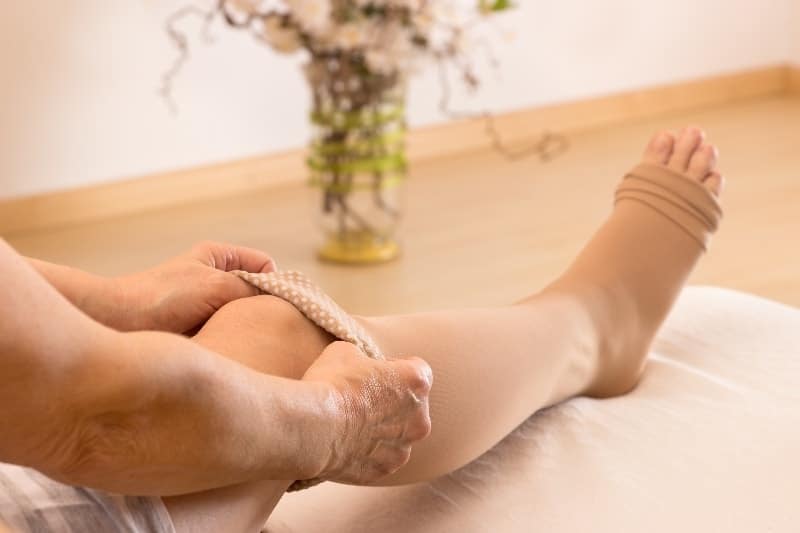
Recommended Compression Socks
Most compression socks can be purchased without a prescription unless you have a condition that requires something custom to be made for you.
Below is a list of compression socks easily found on Amazon based on individual categories. I recommend getting at least two pairs, once you’ve found the pair you love, so you are never left without a pair when the other is in the wash.
In terms of pricing, compression socks range anywhere from $10 – upwards of $100 per pair depending on the level of compression, fiber used and if they are a custom make or not. I never go for the $10 pair because in my experience they fall down, even when I have been fitted appropriately. But at the same time spending $80 on a pair just for run-of-the-mill daily activities seems a little extreme.
Here are my recommendations from years of trialing compression socks.
Best Overall: Sockwell Elevation Firm Graduated Compression Socks
Most Popular On Amazon: Physix Gear Compression Socks
Best Value: SB Sox Lite Compression Socks
Special Mention – American Made: Boldfoot Socks
Summary: Should I Wear Compression Socks At Work?
For almost everybody, even the mildest form of compression will help minimize leg aches and reduce swelling after a long day on your feet.
But you should always consult your doctor if you have any pre-standing health condition or you’re simply not sure it’s a good way to go.
Don’t forget to take them off before bed. You don’t need them on in bed unless your doctor specified it.
We hope this helped you finally feel some relief after a busy day at the office on your feet!
P.s. If you are a new nurse, check out Nursing Survival Kit HERE and get on top of that anxiety I know you’re probably losing sleep over.
Cheers,
Emma


